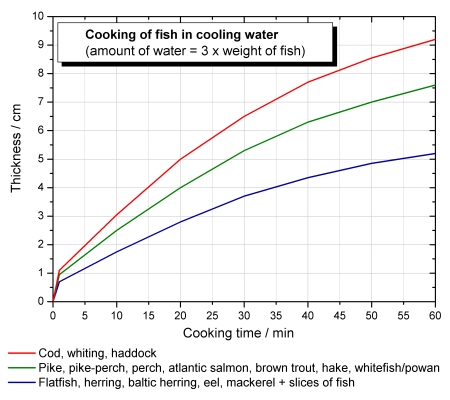I have previously written about how you can cook a perfect steak with a simple DIY sous vide technique. Of course low temperature cooking applies equally well to fish with the only difference that the temperature can be turned down even lower.
A slightly different approach for cooking fish was presented by Haqvin Gyllensköld in the Swedish book “Koka, steka, blanda” from 1977, which I became aware of through í–sten Dahlgren’s book “Laga mat – hur man gör och varför”. In stead of keeping the fish at a constant temperature (which requires quite some attention unless you have a thermostated waterbath), in this method, as the hot water cools, the temperature of the fish increases until they’re at the same temperature.
This is how you do it:
- Weigh the fish
- Boil the triple amount of water
- Add some salt to the water (15 g / L)
- Put the fish in the water and remove the pot from the stove
- Check the graph below for how long the fish should be left in the cooling water
- Serve!

Need help on fish names in different languages? Yeah, me too!

You should switch the axes on the above curve, since presumably the fish thickness is the independent variable – which should just make it easier to read off the required cooking time.
[…] this recipe. First, it’s cooked with the heat turned off (which probably has something which Molecular Gastronomy could explain better then me), and secondly, the resulting stock liquid can be turned into a soup […]
At the Response: Poached chicken breast…
This recipe is really great, but I need to get assurance that this recipe meets all hygienic and food safety regulations. According to the HACCP standards for preparing poultry (check the table in the Food Safety and Inspection Service of the US Department of Agricultures) the critical control point is 25 minutes of simmering a boneless chicken breast. Does the cooling preparation is in accordance with this requirement?
Just need a scientific opinion!
Vladimir: If you’re concerned about safety – check out Douglas Baldwin’s article “A practical guide to sous-vide cooking” – it’s the single best resource on low temperature cooking and food safety. It has tables for recommended pasteurisation times for different types of meat (poultry, beef, pork and fish).
Thank you, Martin,
The resource you linked me to is really useful!
Sorry, but does cooking time depend on fish weight? I think, more weight – more time to cook. Or I am not right?
Thickness will be related to weight – thicker slices need more time. The weight of the fish will determine how much water to start with.
A few details missing in your article that I’d really appreciate before diving into the boiling-but-cooling water:
* Is the fish vacuum packed, or is it being poached?
* Is this whole fish, steaks, fillets, …?
* What should the temperature of the fish be?
1) You just drop the fish as it is into the water. No plastic bag.
2) Whole fish, steaks or fillets will all work – just measure the thickness and read the appropriate time out of the graph.
3) The fish is taken directly from the fridge.
very nice method. i would like to try out some experiments with the same and try to cook it in flavoured water, wit lemongrass, coriander stems, and some things, might be nice too..
Very interesting.
What happens during long cooking times? – Everything goes cold I suppose.
is there such a thing as a crossing temperature? I.e. given the volume of water we know roughly its speed of cooling in a standard kitchen (say 25 deg C). I would expect about 50 degrees? How does this compare with a taste of warm?
Amazing blog by the way!
Yes – for long cooking times everything will eventually go cold. For the speed of water cooling, check out the graphs in my post on how well cast iron and stainless steel pots keep warm:
http://blog.khymos.org/2007/03/01/staying-warm-cast-iron-vs-stainless-steel/
flavour the water (1 sliced onion, 1 bundle of parsley,7 black whole peppercorns, 1 sliced leek, 3 tablespoons of salt to 2-3 liters of water), chill in fridge overnigth and you have something beutiful to serve cold.(whole fish, head and tale connected with a string to make a U-form, skin removed when cold)
goes well with scrambled eggs, mayonaise and bread.
recipe is from Arne Brimi, Norwegian chef, only he keeps it rather hot for 20 minutes.
should work well this way too. recipe is for sea trout